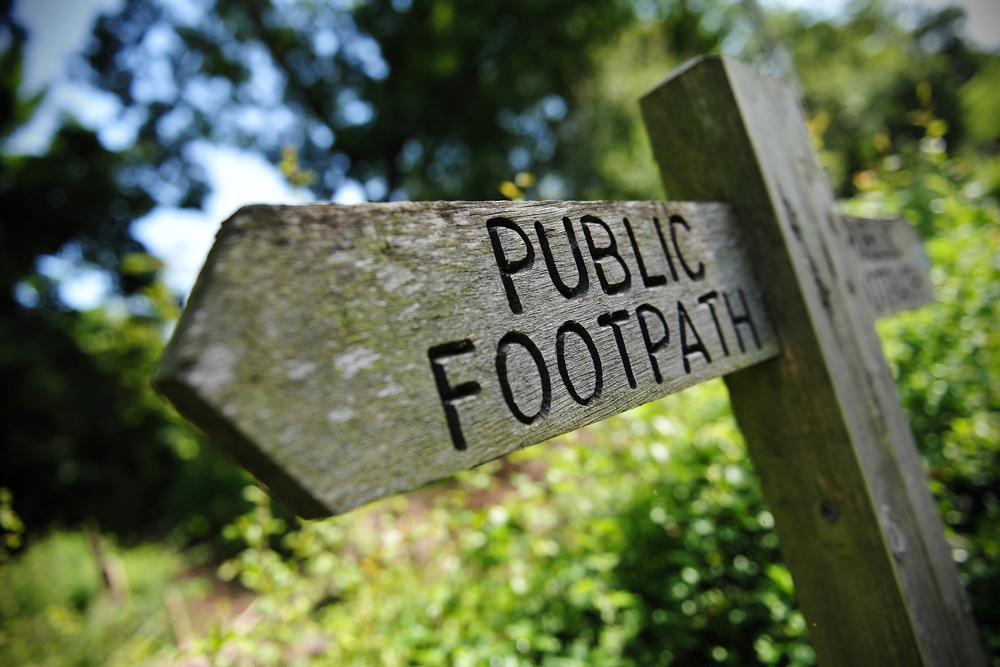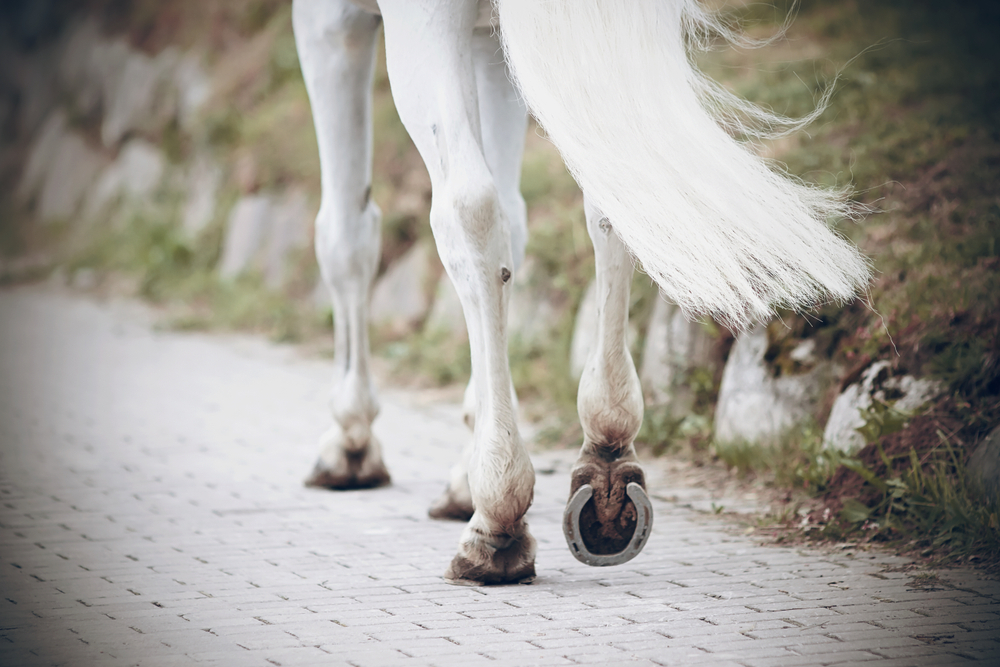- Your source for stall mats, rubber arena footing, arena harrows and arena dust control.

Many a horse rider enjoys a good hack. But it is terribly awkward to be out and about with your mates when some farmer starts bellowing that you are all trespassing. Then your mates start yelling that it is a public footpath, so they are doing nothing illegal. So much fuss. Meanwhile, you have no idea if horse riders can use public footpaths. Who is right? Both.
Horse riders in England and Wales should stick to riding on bridleways, byways, and land they’ve been given permission to ride on. While horse riders can, technically, ride on a footpath, they will be trespassing. This is because a footpath is defined as “over which the public has a right-of-way on foot only.”
Horse riding on a footpath is deeply frowned upon and is only not illegal due to the semantics of the law. Yes, horse riding on a footpath isn’t technically illegal, unless a Traffic Regulation Order or a local bylaw prohibits equestrian use. But because landowners are only required to allow pedestrians to cross their land via the footpath, horse riders are trespassing.
Horse Riding on Public Footpaths
While not technically illegal, horse riders should avoid riding on public footpaths. It will be considered trespassing, as the landowner is only required to allow pedestrian traffic. Footpaths are designed for pedestrian use. Walking a dog, so long as it is controlled, and the use of prams, pushchairs, and wheelchairs are also permitted.
Riding a horse on a public footpath is dangerous. They are only designed for foot traffic, and pedestrians could be put at risk. Don’t do it.
Horse Riding on Bridleways and Byways Open to All Traffic
Horse riders may use bridleways, restricted byways, and byways open to all traffic (BOAT).
Bridleways are also open to bicyclists and walkers.
Byways open to all traffic (BOAT) also allow motorists, bicyclists, motorcyclists, and pedestrians.
Restricted Byways are much like bridleways, open to bicyclists, horse riders, and pedestrians.
Wales also allows horse riding in some of their woodlands that Natural Resource Wales manages.
Remember, you do need to know the arm signals for traffic when hacking. Nor are you allowed to transport a second person. One horse for one person. Do familiar yourself with all rules and safety tips
when hacking. Nor are you allowed to transport a second person. One horse for one person. Do familiar yourself with all rules and safety tips .
.
Right-of-Way on Bridleways and Byways Open to All Traffic
When it comes to right-of-way, horse riders must give right-of-way to pedestrians. Bicyclists are to give right-of-way to both pedestrians and cyclists. Motorists are to give right-of-way to pedestrians and horse riders, but obviously, you need to stay alert. Motorists will be in the wrong in they don’t give right-of-way, but it is you and your horse that will ultimately pay the price.
but obviously, you need to stay alert. Motorists will be in the wrong in they don’t give right-of-way, but it is you and your horse that will ultimately pay the price.
Also note, horse riders are permitted to deviate from the path to get past an obstruction or in the event of allowing a pedestrian to pass safely. However, you cannot go off the bridleway to canter and gallop across a field. You are to stick to the designated paths unless deviation is unavoidable.
Obstructions and Gates on Bridleways and Byways
Be aware that while it is illegal for landowners to obstruct bridleways and byways, they are allowed to put up unlocked gates. Should you encounter a gate while hacking, and there is no friendly pedestrian around to assist, you will need to dismount or learn how to open and close a gate while on your horse.
The British Horse Society has provided an informative YouTube video on how to open and close a gate while on a horse: https://www.youtube.com/watch?v=U79lvic1gAE
Horse Riding on Motorways and Highways
Horse riding is not allowed on motorways and highways.
There may be times where the bridleway or byway crosses a motorway or highway. In this instance, the horse rider must use the established crossing. There may be signs that state “horse rider dismount,” which you must obey , crossing by leading your horse rather than riding.
, crossing by leading your horse rather than riding.
Roundabouts are to be avoided if at all possible. If there is no alternative:
- Watch for all vehicles while keeping to the left.
- Signal right when passing an exit you are not leaving.
- Signal left when preparing and exiting the roundabout.

Where You Can Use a Horse Drawn Carriage
Horse-drawn carriages are allowed on restricted byways. Wales will also allow carriage driving in some of their woodlands managed by Natural Resources Wales .
.
If you are venturing out onto highways, it is best to consult the Code of Practice for Horse-Drawn Vehicles.
The Department for Transport does have a Code of Practice for Horse-Drawn Vehicles . The code is aimed at commercial operations that are transporting paying passengers. Like driving a car or a motorcycle, there is a test, fee, and certificate. Once passed, the drivers must obey all guidelines, including in regards to their equipment.
. The code is aimed at commercial operations that are transporting paying passengers. Like driving a car or a motorcycle, there is a test, fee, and certificate. Once passed, the drivers must obey all guidelines, including in regards to their equipment.
Those driving horse-drawn carriages for private use are not required to take the test. But it is highly encouraged to consult the code of practice, nonetheless.
Safety Gear While Hacking
When hacking, there is safety equipment that you and your horse should be wearing.
- Riding helmets. While the law only requires children under 14 years of age to wear a helmet, everyone should be wearing one. (Sikh riders that wear a turban are exempt from these rules.
 )
) - Footwear is required and should have hard heels or soles.
- Florescent and light-colored clothing for daytime riding is highly recommended.
- Reflective clothing is required for night riding (although night riding is not encouraged).
- Horses must have reflective bands on their fetlock joints on night rides.
- Riders must also have a light that shows white to the front and the back. It is advised these lights be secured to the rider’s right arm or leg.
- If leading the horse at night, you must carry a white light in your right hand that displays to the font and a red to the back. Like riding, you and the horse are to wear fluorescent and reflective clothing.
- Florescent and or reflective tail guards are not required but are recommended.
You can learn more about high-visibility clothing for horse riding here .
.
Other Recommended Safety Gear and Tips While Hacking
Just because the rules don’t require you to do it doesn’t mean it isn’t a good idea. Here are some other tips and safety gear that are recommended.
- Tell a friend who isn’t riding in the group when and where you are going.
- Bring a fully charged mobile (cell) phone while riding. It is best that the phone also has an ICE (In Case of Emergency) programmed on it.
- Wear a band or have a card on you that IDs you and has any critical medical information, such as listing any allergies, chronic conditions, and medication you are taking.
- Tag the horse’s saddle with its barn, yard, or stable information and your contact details.
- Consider wearing a body protector. These can help reduced injury when falling off, especially if the horse accidentally kicks you, steps on you, or rolls over you.
- Air jackets offer further protection if worn over a body protector. They are considered to provide little protection if worn alone, however.
- Gloves help protect you from the sun, assist with grip, and will offer some protection.
- Consider a first aid kit for you and your horse to take on your hack. You can get some tips on putting these together here. You can make adjustments to the recommendations depending on how much you can carry and what you feel is truly essential for your type of outing.
Conclusion
While horse riding on a footpath is not something you should do, there are plenty of options out there, from bridleways to byways. Hacking can and should be fun, but do it as safely as possible.
Sources
https://www.bhs.org.uk/advice-and-information/free-leaflets-and-advice/faqs

